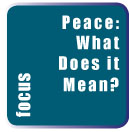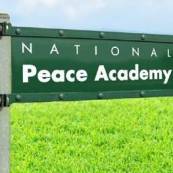 by the National Peace Academy
by the National Peace Academy
The National Peace Academy’s understanding of peace is shaped by the definition contained in the Earth Charter: “…peace is the wholeness created by right relationships with oneself, other persons, other cultures, other life, Earth, and the larger whole of which all are a part.â€
This principle of right relationships is embedded in nearly all faith, spiritual and ethical traditions. In the Christian faith it is represented by the Golden Rule “do unto others as you would have them do unto you.†This ethic of reciprocity is a foundational tenet of all the world’s major religions. From a more secular, human rights perspective, the idea of right relationships is expressed in terms of human dignity. The preamble of the Universal Declaration of Human Rights begins by recognizing “the inherent dignity and the equal and inalienable rights of all members of the human family (as) the foundation of freedom, justice and peace in the world.â€
What is Peacebuilding?
 The National Peace Academy makes use of John Paul Lederach’s conceptualization of peacebuilding which he describes as “a comprehensive concept that encompasses, generates and sustains the full array of processes, approaches and stages needed to transform conflict toward more sustainable, peaceful relationships.â€
The National Peace Academy makes use of John Paul Lederach’s conceptualization of peacebuilding which he describes as “a comprehensive concept that encompasses, generates and sustains the full array of processes, approaches and stages needed to transform conflict toward more sustainable, peaceful relationships.â€
The purpose and scope of peacebuilding is oriented towards nurturing citizen capacities and the political, economic and social structures necessary for assuring the conditions for positive peace.
Betty Reardon describes positive peace as constituting the conditions for the existence of “‘justice,’ in the sense of the full enjoyment of the entire range of human rights by all people.â€
Thus, the concerns and problems that peacebuilding addresses are wide ranging, including – but not limited to – issues of poverty, social and economic inequity, violence, environment and resource degradation, racism, and gender discrimination.
Peacelearning Builds the Peacebuilder
Peacelearning is the process through which the National Peace Academy facilitates learning toward the full development of the peacebuilder. Peacelearning emphasizes learning as an essential capacity of peacebuilding. As such, peacelearning is much more than simple acquisition of new knowledge and skills; it is a transformational process in which new information and ideas are integrated into the knowledge and experiences we already have.
Peacelearning is directed toward both inward and outward change. It is a learner-centered process that is non-hierarchal and elicitive, seeking to draw forth knowledge from the individual learner. It invites learners to engage in modes of critical thinking and self-reflection that are necessary for internalizing the principles and processes of peace. It also capacitates learners to pose critical queries and questions that may lead to new understandings and possible solutions to personal, interpersonal, social, economic, political and environmental problems for which no answers currently exist. Peacelearning nurtures those capacities that are essential for learners to be agents of personal and social change.
The above understandings of peacebuilding and peacelearning, considered together with the Earth Charter definition of peace as rooted in right relationships, promote a very active conception of peace and the dynamic and transformative learning required to pursue and achieve it. Additionally, these concepts illuminate at least four spheres of peace that need to be nurtured toward the full development of the peacebuilder: the personal, the social, the political and the ecological.
Getting Trained
The Peacebuilding Peacelearning Intensive will introduce participants to theory and practices for nurturing peace in each of these spheres.
The personal: In the personal sphere, peace requires that we actively strive to establish right relationship with our self. Personal peace is pursued through inquiry into how we manage and act upon our internal conflicts, attitudes, actions, and emotions toward living with integrity.
The social: In the social sphere, peace requires that we actively strive to establish right relationships with others. Social peace is pursued through inquiry into our attitudes, intentions, and actions regarding how we manage our interpersonal conflicts and differences, and how we give to and receive from others the qualities and conditions that comprise human dignity.
The political: In the political sphere, peace requires that we actively strive to establish right relationships with groups of people, communities and organizations that are supported by just, nonviolent procedures for making and implementing policy and planning decisions in government, business, and civil society. Political peace is pursued through inquiry into our attitudes, intentions, and actions regarding how we engage in decision-making processes, and how we review and assess existing institutions and mechanisms as well as those we strive to establish for assuring peace and justice.
The ecological: In the ecological sphere, peace requires that we actively strive to establish right relationships with Earth and its ecosystems of which we are a part and on which our survival and quality of life depend. Human systems are not separate from, but integral to all living systems and as such, human organization affects and is affected by all other ecological systems. Ecosystems are both resilient and fragile, and human life depends upon our respect for and stewardship of the entire planet. Ecological peace is pursued through inquiry into our attitudes, intentions, and actions regarding how we take responsibility to shift our relationship to the natural environment from one based on control over, to one based on interdependence and living with and within.
The National Academy of Peace will sponsor a Peacebuilding Peacelearning Intensive Overview, August 1-7, 2010, at Wilmington College, Wilmington, Ohio. For more information, visit http://www.nationalpeaceacademy.us/index.php?option=com_content&task=view&id=220&Itemid=49. Φ
